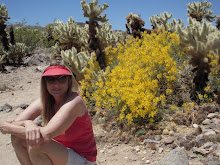 At the turn of the 20th Century, following the Gold Rush of 1848, population growth in Southern California exploded. Railroad lines expanded, linking the West Coast to the East. The lure of cheap land and warm weather drew thousands. In 1914, the opening of the Panama Canal made the port of Los Angeles the most heavily trafficked in the area. By 1920, the city's population swelled to one million, and soon doubled.
At the turn of the 20th Century, following the Gold Rush of 1848, population growth in Southern California exploded. Railroad lines expanded, linking the West Coast to the East. The lure of cheap land and warm weather drew thousands. In 1914, the opening of the Panama Canal made the port of Los Angeles the most heavily trafficked in the area. By 1920, the city's population swelled to one million, and soon doubled.The local deserts, accessible by car, became a popular destination. This led to a gardening fad in the 1920s: the fascination with "exotic" desert plants. Visitors traveled to the desert and uprooted scores of indigenous plants to take home. By 1930, Devil's Garden, south of Joshua Tree, home to thousands of cacti and yuccas, was picked bare. The area has never recovered. Another popular trend of that time was to set fire to Joshua trees to use as torches to guide drivers motoring at night. While some people delighted in the new found desert fads, others grew concerned.
Minerva Hamilton Hoyt, an avid gardener and Pasadena socialite, had moved from Mississippi to Southern California in the 1890s. After the death of her husband and infant son, the local desert, to which she made frequent trips, provided comfort. Leaving her genteel life behind, she often traveled to the desert by wagon or horse.
Minerva Hamilton Hoyt did many things to raise the profile and the plight of the local desert. In 1927 she designed a desert conservation exhibit for the Garden Club at America's flower show in New York City. After, she headed the newly formed Desert Conservation League in Los Angeles. Several times she approached the National Park Service requesting that the area south of 29 Palms become a federal park. By that time the Depression had hit the nation hard, and President Hoover showed little interest.
In 1932 President Franklin Roosevelt took office. To create jobs under the New Deal, he decided to support Mrs. Hoyt's crusade, and set aside 825,000 acres of desert land. In 1936, Roosevelt signed a proclamation that established Joshua Tree National Monument. The remaining challenge was the 8,000 privately owned mining claims that lay scattered over the Monument. Over the next three decades, most of the mines became abandoned and were reclaimed by the government. In 1950, to satisfy mining interests, 280,000 acres were returned to the public domain.
Congress passed the Wilderness Protection Act in 1964. Then, on October 31, 1994, President Clinton signed the Desert Protection Act, which transferred three million acres of land to the National Park Service. 234,000 of those acres were added to the Monument, creating Joshua Tree National Park. Finally, the fruits of Mrs. Hoyt's labor were seen. Because of her efforts, Minerva Hamilton Hoyt has been named Apostle of the Cactus.
desert trivia: According the National Park Service, the current size of Joshua Tree National Park is 794,000 acres. Over 1.2 million visitors travel to the park each year.
(photo, 2007: mural of Minerva Hamilton Hoyt at the Joshua Tree National Park Visitors Center in 29 Palms)

No comments:
Post a Comment